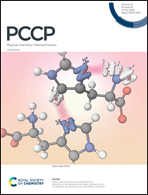Anchoring boron on a covalent organic framework as an efficient single atom metal-free photo-electrocatalyst for nitrogen fixation: a first-principles analysis†
Abstract
The production of ammonia in a sustainable cost-effective manner and ambient conditions is a very challenging task. Photo-/electrocatalytic nitrogen reduction (NRR) is a convenient way to produce NH3 for industrial applications. In this work, anchoring B atoms in Tp-bpy-COF is shown to effectively reduce N2 to NH3. By employing density functional theory, we demonstrated that N2 can be efficiently activated on the B center due to the synergistic effect of B–N. Meanwhile, we found that the NRR happens predominantly by the alternating path with a small limiting potential of 0.13 V. Moreover, the suitable band edge positions and broad visible light absorption zone result in B@Tp-bpy-COF acting as a promising photocatalyst. Our proposed catalytic system exhibits favorable formation energy and excellent structural stability during AIMD simulations, which suggest the feasibility of experimental synthesis. The system turns out to be highly selective toward the NRR compared to other competitive reactions. These findings may pave a new way for designing SACs on COFs for N2 fixation with high activity, which may also apply to other reactions.

- This article is part of the themed collection: 2022 PCCP HOT Articles


 Please wait while we load your content...
Please wait while we load your content...